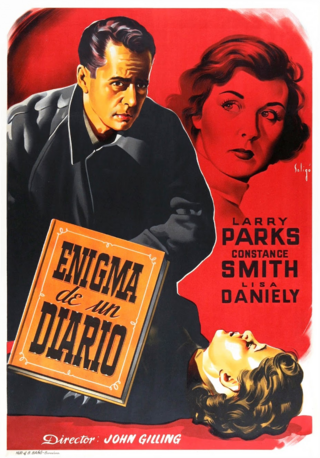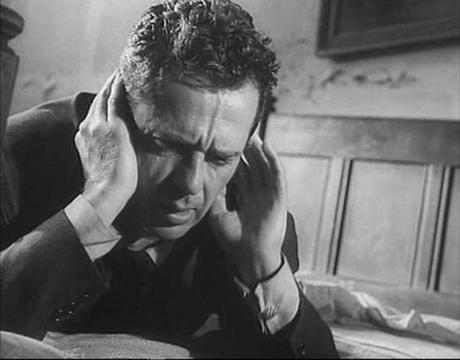
The last time I posted here I spoke about voiceover narration in movies and expressed some doubts about its efficacy. Now that was largely prompted by my experiencing what I felt was a fairly redundant example of the technique. That said, the fact is that this narrative device does serve a purpose and, as others have pointed out, is frequently an attractive feature in various films noir. Generally, I'd go along with that - although it has to be said that a recent viewing of Richard Fleischer's Trapped had me drumming my fingers at what seemed like an interminable lecture at the beginning. And this, in my own meandering way, brings me to Tiger by the Tail (1955), a British film noir which I reckon uses its narration in the most effective way, that is as a means of conveying the thoughts, fears and regrets of the lead.
The opening is suitably evocative - nighttime, a sparse urban setting and a lone figure stumbling along a pavement before collapsing. As a patrol car pulls up and a policeman goes to attend to the fallen man the credits roll. Thereafter the story unfolds in flashback, with intermittent narration provided by the protagonist. He is John Desmond (Larry Parks), an American journalist somewhat reluctantly handed the assignment of taking over the London office of his organization. He'd been expecting the Paris job and the last minute decision to switch him to Britain hasn't done much for his mood. The combination of post-war austerity and the less than enchanting weather is picking at him and a decision to go out for a drink alone proves to be a fateful one. This is what brings him into contact with Anna Ray (Lisa Daniely), and he embarks on a relationship that will see him embroiled in a killing and left to the mercy of a group of ruthless counterfeiters. His only way out is to try to unravel the meaning of a cipher in a notebook, and thus hopefully bring down the gangsters. As is often the case in the world of film noir, Desmond has first to be led up the garden path by a femme fatale in the shape of Ms Ray before being bailed out by a loyal Girl Friday figure - in this case Jane Claymore (Constance Smith), the secretary who proves herself considerably more resourceful than her ill-fated boss.

As films noir go, the plot here is pretty standard fare. There's a protagonist who's not exactly a chump but nor is he any brighter than he needs to be. The villains are twisty and mean, and the women, both good and bad, are arguably sharper than anyone. The script adapts a John Mair novel and comes via Willis Goldbeck. Generally a writer and occasional director (I keep meaning to do something catching up with Ten Tall Men, the Foreign Legion picture he made with Burt Lancaster), Goldbeck penned a number of Dr Kildare programmers as well as a couple of Stuart Palmer adaptations , not to mention the deeply unpleasant Freaks for Tod Browning. Tiger by the Tail is a smoothly written piece, albeit a seemingly unusual one for a man close to the end of his career and due to go out on a relative high with a brace of John Ford movies - Sergeant Rutledge and The Man Who Shot Liberty Valance.
The movie looks attractive throughout and is set up nicely by that generic but stylish and effective opening. The cinematography is Eric Cross (who also shot the visually interesting The Dark Man) and the always reliable John Gilling occupies the director's chair. Gilling had an eye for a good-looking setup and even if he was as abrasive as his reputation suggests he did, as a rule, manage to get solid or better performances from the actors he worked with. He remains something of an underrated filmmaker although, interestingly, the upcoming Hammer box set from Indicator/Powerhouse is as near a John Gilling collection as we're likely to see.

And so to the actors. Neither Larry Parks nor Constance Smith will be household names these days, and indeed I'd be amazed if anyone aside from the most dedicated film buffs are at all familiar with them. Nevertheless, back when Tiger by the Tail went into production both would have enjoyed a considerably higher profile. For different reasons these two people dropped virtually out of sight after having tasted success. One would have though a Best Actor nomination in a big budget movie would ensure a more lasting fame, but such was the power of the blacklist that someone like Parks could see his career grind to a halt almost immediately. I'll have to confess that I've not seen much of his work and can only recall The Swordsman, a fairly entertaining Joseph H Lewis swashbuckler.
Constance Smith fell from grace for entirely different reasons, although her troubles are not unprecedented in Hollywood. Coming from a poor Irish background, Smith quite literally shot to fame and found herself rapidly moving from Rank in Britain to Fox in Hollywood and making star appearances alongside some major names. However, as fast as her fame arrived, it evaporated at a similarly giddy pace. Out of contract, with a personal life descending into chaos, she left the US but the years ahead were to be even more tumultuous. Not that any of this is apparent when watching Tiger by the Tail, where her performance is just fine.
Recent years have been good to fans of British crime and noir. There was a time when these kinds of movies were sprinkled throughout the TV listings, albeit as filler material. Then they seemed to disappear, leaving many wondering if they'd ever be seen again. Small independent labels such as Renown, along with Network and Simply, have done some terrific work in making so many of these forgotten titles available once again. The Renown DVD of Tiger by the Tail has the movie looking quite good; the contrast might be a touch harsh here and there and there are a few damaged frames, but it's not at all a bad presentation. All in all, I found it a solid little film noir with some highly competent talent behind the camera, and a couple of very interesting stars in the leading roles. In short, an enjoyable movie.
